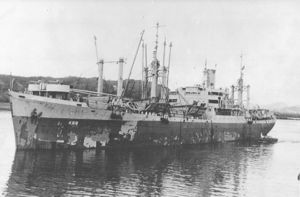USS Oberon (AKA-14)
 USS Oberon as AK-56 USS Oberon as AK-56 | |
| History | |
|---|---|
| Laid down: | Unknown |
| Launched: | 18 March 1942 |
| Commissioned: | 15 June 1942 |
| Decommissioned: | 27 June 1955 |
| Struck: | Unknown |
| Fate: | Scrapped, 1971 |
| General Characteristics | |
| Hull type: | C2-F |
| Displacement: | 7,391 tons |
| Length: | 459 ft 2 in (140 m) |
| Beam: | 63 ft (19.2 m) |
| Draft: | 26 ft 5 in (8.0 m) |
| Propulsion: | one 2-stroke, 4 cylinder single-acting Doxford diesel, single propeller, 6,000 shp (4.5 MW) |
| Speed: | 16.5 knots (31 km/h) |
| Complement: | 494 |
| Armament: | 1 × 5"/38 caliber DP gun, 4 × 3" guns (type unknown), 8 × .50 caliber machine guns 2 × depth charge projector |
| Boats: | 8 LCM, 14 LCVP |
USS Oberon (AK-56/AKA-14) was an Arcturus-class attack cargo ship of the U.S. Navy. She was named after Oberon, one of the moons of the planet Uranus. Commissioned as AK-56, she was designated AKA-14 seven months later. Oberon received six battle stars for World War II service and five for duty in the Korean War.
1940s
Oberon (AK–56), originally named Delalba (MC hull 133), was built at Federal Shipbuilding & Drydock Company, Kearny, N.J.; renamed Oberon 16 February 1942; launched 18 March 1942; sponsored by Mrs. W. Creighton Peet; acquired by the Navy 15 June 1942, commissioned the same day, Comdr. Ion Purcell in command.
Oberon completed alterations and shakedown before joining a task force steaming to invade North Africa, 24 October 1942. Despite air raids, a submarine attack, and casulties among sister ships, she commenced off loading supplies D-Day, 8 November, at Fedela, French Morocco. Mission accomplished, the cargo ship returned to Hampton Roads, Va., 24 November and began preparations for a Pacific voyage.
Early in the new year, Oberon transited the Panama Canal; and, while sailing for the South Pacific, was reclassified AKA–14. She discharged her cargo at New Caledonia and the New Hebrides before returning to Norfolk, 12 March 1943. Completing overhaul AKA–14 again crossed the Atlantic to the Mediterranean and took station, 10 July, off Gela for the landings on Sicily. Two months later her antiaircraft batteries again blazed during unloading operations in the difficult invasion of Salerno Bay, Italy. Withdrawn to sail the Oran to Bizerte supply run, Oberon departed the area 1 December with 120 Army paratroopers and supplies bound for Belfast, Northern Ireland. Later that month an Atlantic storm caused more damage than had enemy actions.
After repairs in the Philadelphia Navy Yard, Oberon returned to North Africa in April via Cardiff, Wales. As part of Assault Group II preparing for operation "Dragoon," AKA–14 practiced landings until 13 August along both the Algerian and Italian coasts. D-day, the 15th, went smoothly as she landed 151 soldiers and sailors plus valuable support equipment at St. Tropez, France. After 5 additional logistic missions from Oran and Naples, the attack transport joined a convoy en route to the United States late in October.
With Germany facing defeat, Oberon was reassigned to the Pacific. Once again she began a new year in transit through the Panama Canal and then proceeded to Leyte, Philippines arriving 21 February 1945. With other units of Amphibious Group 7 she helped to take Kerama Retto late in March and joined the attack on Okinawa 1 April. The appearance of kamikaze planes the next day was a challenging new experience from which AKA–14 emerged unscathed and with one kill to her credit. She retired 26 April to the South Pacific and later received news of Japan’s capitulation while steaming to the Philippines. With occupation troops from the 81st Division embarked she sailed into port at Aomori, on northern Honshū, 25 September. After an additional voyage to Yokohama, Oberon turned homeward and early in December reached San Francisco, California.
In postwar years, Oberon served with the Navy Transportation Service carrying cargo and personnel between the West Coast and American bases in the Pacific. Incorporated into the Military Sea Transportation Service at its initiation, 1 October 1949, she became an ammunition replenishment vessel during the Korean Conflict.
1950s
Arriving Sasebo, Japan, 15 January 1951, AKA–14 remained 7 months serving in this new war zone. On 9 March she conducted her first rearming-at-sea mission with carriers, and later much of her time was spent shuttling supplies between Sasebo and Wonsan, Korea. A second tour of duty in the war zone occurred during the first five months of 1952.
The truce signed at Panmunjom curtailed her assignments. She decommissioned 27 June 1955 and was placed in the Reserve until struck from the Navy List, 1 July 1960. She was transferred to the Maritime Commission, placed in the National Defense Reserve Fleet, and berthed at Olympia, Washington into 1970.
References
- Dictionary of American Naval Fighting Ships (Primary source for this article)